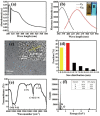Preparation of carbon quantum dot fluorescent probe from waste fruit peel and its use for the detection of dopamine
- PMID: 38192308
- PMCID: PMC10772540
- DOI: 10.1039/d3ra06799h
Preparation of carbon quantum dot fluorescent probe from waste fruit peel and its use for the detection of dopamine
Abstract
Carbon quantum dots (CQDs), as a new type of fluorescent nanomaterial, are widely used in the detection of small molecules. Abnormal dopamine secretion can lead to diseases such as Parkinson's disease and schizophrenia. Therefore, it is highly significant to detect dopamine levels in the human body. Using discarded fruit peels to prepare carbon quantum dots can achieve the reuse of kitchen waste, reduce pollution, and create value. Nitrogen-doped carbon quantum dots (N-CQDs) were prepared using the hydrothermal method, with orange peel as the raw material. The fluorescence quantum yield of N-CQDs reached a high value of 35.37% after optimizing the temperature, reaction time, and ethylenediamine dosage. N-CQDs were characterized using various techniques, including ultraviolet visible (UV-vis) spectroscopy, fluorescence spectrophotometer (PL), transmission electron microscopy (TEM), and Fourier transform infrared spectroscopy (FT-IR). These analyses confirmed the successful doping of nitrogen in the CQDs. The DA concentration ranged from 0 to 300 μmol L-1, and the linear equation for fluorescence quenching of N-CQDs was F/F0 = -0.0056c + 0.98647, with an R2 value of 0.99071. The detection limit was 0.168 μmol L-1. The recovery and precision of dopamine in rabbit serum were 98% to 103% and 2% to 6%, respectively. The prepared N-CQDs could be used as a fluorescent probe to effectively detect DA.
This journal is © The Royal Society of Chemistry.
Conflict of interest statement
There are no conflicts to declare.
Figures







Similar articles
-
Green Preparation of Fluorescent Nitrogen-Doped Carbon Quantum Dots for Sensitive Detection of Oxytetracycline in Environmental Samples.Nanomaterials (Basel). 2020 Aug 8;10(8):1561. doi: 10.3390/nano10081561. Nanomaterials (Basel). 2020. PMID: 32784490 Free PMC article.
-
Biocompatible sulfur nitrogen co-doped carbon quantum dots for highly sensitive and selective detection of dopamine.Colloids Surf B Biointerfaces. 2021 Sep;205:111874. doi: 10.1016/j.colsurfb.2021.111874. Epub 2021 May 23. Colloids Surf B Biointerfaces. 2021. PMID: 34044332
-
Highly photoluminescent N, P doped carbon quantum dots as a fluorescent sensor for the detection of dopamine and temperature.J Photochem Photobiol B. 2019 May;194:61-70. doi: 10.1016/j.jphotobiol.2019.01.004. Epub 2019 Mar 20. J Photochem Photobiol B. 2019. PMID: 30927703
-
Innovative Cerium and Chromium Co-doped Carbon Quantum Dots: Synthesis, Smartphone-Compatible and Sensitive Fluorescence Approach for Detection of Vitamin B12.J Fluoresc. 2025 Feb 13. doi: 10.1007/s10895-025-04165-6. Online ahead of print. J Fluoresc. 2025. PMID: 39945988 Review.
-
A Review on Characterization Techniques for Carbon Quantum Dots and Their Applications in Agrochemical Residue Detection.J Fluoresc. 2022 Mar;32(2):449-471. doi: 10.1007/s10895-021-02852-8. Epub 2022 Jan 22. J Fluoresc. 2022. PMID: 35064386 Review.
Cited by
-
Preparation of Carbon Dots with High Fluorescence Quantum Yields and its Detection of Hg2+ in Simulated Wastewater.J Fluoresc. 2025 Jan 9. doi: 10.1007/s10895-024-04093-x. Online ahead of print. J Fluoresc. 2025. PMID: 39786691
-
Waste Egg Tray Paper Pulp Derived Carbon Dots for Detection of Fe3+ Ions via Fluorescence On-Off Process.J Fluoresc. 2025 Jun 20. doi: 10.1007/s10895-025-04407-7. Online ahead of print. J Fluoresc. 2025. PMID: 40540197
-
Eco-friendly synthesis of Carbon Quantum Dots (CQDs) from hazelnut husk for sensitive Aflatoxin B1 (AFB1) detection.Toxicol Rep. 2024 Nov 22;13:101824. doi: 10.1016/j.toxrep.2024.101824. eCollection 2024 Dec. Toxicol Rep. 2024. PMID: 39649378 Free PMC article.
-
Preparation of Biomass Waste-Derived Carbon Dots by the Thermal Degradation Process.ACS Omega. 2025 May 27;10(22):22529-22548. doi: 10.1021/acsomega.4c10119. eCollection 2025 Jun 10. ACS Omega. 2025. PMID: 40521563 Free PMC article.
-
A ratiometric electrochemiluminescent strategy for sensitive detection of dopamine based on g-C3N4/luminol-functioned carbon spheres.Mikrochim Acta. 2025 May 16;192(6):357. doi: 10.1007/s00604-025-07211-z. Mikrochim Acta. 2025. PMID: 40377715
References
-
- Yang Y. N. Wang H. Wu Y. W. Yu X. X. Spectrochim. Acta, Part A. 2022;265:120385. - PubMed
-
- Pan J. F. Miao C. F. Chen Y. T. Ye J. H. Wang Z. Z. Han W. D. Huang Z. J. Zheng Y. J. Weng S. H. Chem. Pharm. Bull. 2020;68(7):628–635. - PubMed
-
- Yang H. L. Bai L. F. Geng Z. R. Chen H. Xu L. T. Xie Y. C. Wang D. J. Gu H. W. Wang X. M. Mater. Today Adv. 2023;18:100376.
-
- Zhang J. Z. Ji X. Ye N. C. Zhang H. T. Sun H. Xu C. Z. Liu L. Ma J. J. Tong Z. W. J. Electrochem. Soc. 2023;170:037502.
LinkOut - more resources
Full Text Sources

